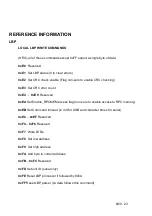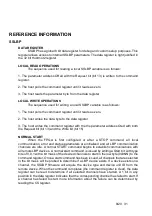
8I20 32
REFERENCE INFORMATION
SSLBP
8I20 DEVICE SPECIFIC SETUP
A normal start command does specific setup operations when it detects a 8I20
remote device. This setup includes clearing any faults, setting the qsetpoint current to 0
A, enabling the current control loop and setting the 8I20s watchdog timer to 40 mS. If no
errors have occurred and all faults are clearable, the SSLBP firmware enters a "chatter"
loop where it repeatedly asks the 8I20 for a cookie character. This keeps the 8I20's
watchdog fed while waiting for the first DOIT command. Once a DOIT command has been
executed, the firmware no longer "chatters" and the host interface must send DOIT
commands at greater than 40 mS intervals or the 8I20s watchdog will bite, disabling its
output.
STOP LBP INTERFACE
A STOP ALL command is issued to stop all channel communication. A STOP ALL
followed by a START command can be used after a fault condition to re-establish
communication with the remote LBP devices. Device discovery is only done once when
START command is issued to a STOPed SSLBP. This means that if cabling or devices
are changed, a STOP ALL command followed by a START command must be issued by
the host to detect the changes.
STOP INDIVIDUAL CHANNELS
In addition to stopping all channels, a individual stop command can be issued. A
individual stop command include a bitmask of the channels to stop in the least significant
8 bits of the command.
DOIT
In normal operation SSLBP is designed to write data from local registers to the
remote device and read remote device data for presentation to the host on a real time
basis. Synchronization is accomplished with the DOIT command. When a DOIT command
is written, all channel data from the host is sent to the remote devices and receive data is
requested. Completion of the DOIT command is signaled by SSLBP clearing the
COMMAND register. A DOIT command contains the DOIT bit and an 8 bit mask in the 8
LSBs that selects the channels that will transfer data. After DOIT command completion
the data register will contain a bit mask of channel status data. If any bit is set in the data
register, it indicates a problem with the transfer (all zeros indicates no faults or errors). The
data returned after a DOIT command can be used to minimize host access cycles by
avoiding the need to read the per channel status registers. If detailed fault information is
desired, the CS register and Interface1 register can be read on any channel that shows a
failed transfer.






































